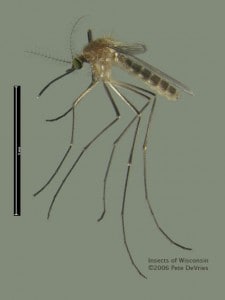I’ve just returned from four days at Big Gull Lake, north of Kaladar. There were far more mosquitoes present than is usual for late July. It appears that Eastern Ontario is having a bad year in general. Below you will find a couple of postings from NatureList Digest, an Eastern Ontario nature listserv that I subscribe to. You can find it at http://groups.google.com/group/naturelist/topics I’d be interested in people’s impression of the mosquito situation in the Kawarthas this summer. It certainly started out quite bad back in May and June.
Drew Monkman
July 30 Mosquitoes have been exceptionally bad everywhere. I don’t understand
why, after a drought in 2012, the mosquito pops in eastern Ontario were
very bad in 2013 and 2014. In previous years living here (21 years) we
would notice a decline in mosquitoes after a dry year. I was told there
are 53 species of mosquito in eastern Ont (of the 74 species that live
in Canada). We notice several different populations throughout the
spring and summer, including tiny fast ones in August which I’ve been
told are the ones that carry West Nile Virus. Right now we’ve got a
small to medium-sized species that buzzes around our faces particularly
eyes and ears. Makes it very unpleasant to garden, etc.
Candice – cvetter@xplornet.com
July 30 Mosquitoes have been bad around here (the N corner of Lanark Co.) this
summer, too, and also at the Macoun Club Study Area in Ottawa’s
western Greenbelt. But as of last week they’ve been different
species: the common summer mosquito Coquilletidia perturbans here, and
Aedes trivittatus in the Greenbelt.
Usually when I collect four or five mosquitoes for identification,
even that small number turns out to be a mix of species. There is a
very good key to adult female mosquitoes (which are what bite us) on
the internet at http://www.biology.ualberta.ca/bsc/ejournal/th_04/th_04.html
. It requires the careful collection of undamaged specimens, the use
of a dissecting microscope, and the determination to learn the
topography of a mosquito’s left side. Once I have a name, I can find
life-history information for at least the more common species online
and make sense of them.
Without taking the trouble to identify the species, I focus on me and
my troubles rather than them and what makes them interesting. The one
introduced species I have encountered is easy to recognize on sight
(close sight!). It is large, black-and-white, and has a distinctive
golden pattern on the back.
As for the very small swarming insects buzzing around Douglas
Thompson’s face, I expect they’re what I call face flies — actually
certain species of Black Flies that feed on other animals but just
swarm humans and hardly ever bite us, such as Simulium tribulatum.
Snatch one our of the air and look at it closely. It probably has the
typical humpbacked appearance of a Black Fly.
Robert Lee – rel@magma.ca
